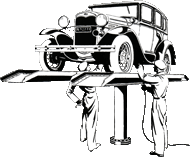
Model A & B
Ford Garage
Rear Main Bearing Caps
This page details the evolution of the Model A and Model B engine rear main bearing caps.
| Bearing Cap | ||
|---|---|---|
| Part Number |
Material | Usage Notes |
| A-6327-A | Type "E" Steel Forging | Rear Main Bearing Cap Early style forging 1928 Model A and AA engines 5/16" diameter A-6321-A drain pipe 3-5/8" length A-21214-A bearing bolt |
| A-6327-A | Type "E" Steel Forging | Rear Main Bearing Cap Later style forging 1928-29 Model A and AA engines 5/16" diameter A-6321-A drain pipe 3-5/8" length A-21214-A bearing bolt |
| A-6327-B | Grade "B" Iron Casting | Rear Main Bearing Cap April 1930-31 Model A and AA engines 3/8" diameter A-6321-B drain pipe 4-3/16" length A-21214-B bearing bolt |
| B-6327 | Grade "B" Iron Casting | Rear Main Bearing Cap 1932-34 Model B and BB engines 3/8" diameter B-6321 drain pipe 4-3/16" length B-6344 bearing bolt |
| Ball Check Oil Drain Tube (Service) | ||
| A-6328-A | Pipe and Ball ~ 5/16-32 thread | 5/16" diameter drain pipe assembly With ball check valve Released for Service for 1928-30 |
| A-6328-B | Pipe and Ball ~ 3/8-32 thread | 3/8" diameter drain pipe assembly With ball check valve Released for Service for 1930-31 |
| B-6328 | Pipe and Ball ~ 3/8-32 thread | 3/8" diameter drain pipe assembly With ball check valve Released for Service for 1932-34 |
Early and Late Forged Steel Bearing Caps

 fordgarage.com
fordgarage.comTypical 1928-29 forged steel rear main bearing caps are shown above and below. The early 1928 cap on the left has less material around the bolt holes as indicated.
Both forged caps use a 3-5/8" long bearing cap bolt which had a 'D' shaped bolt head. This style head shape was used used through 1934, on varying length bolts.
Some early rear bolts may have had a square head similar to the front and center caps, though the drawing record at the Benson Ford Research Center has not yet been located. Possibly the style of bolt with a clipped square head was a non-Ford aftermarket item.
Note: The threaded oil drain tube was spot gas welded to the cap after assembly to prevent loosening or loss. This can be seen in the pic above.

 fordgarage.com
fordgarage.comThe pic above shows the reduced material and strength around the bolt hole of the early forged steel cap on the left versus that of the typical forged steel cap.
Model A Type "E" Steel Forging versus Grade "B" Iron Casting

 fordgarage.com
fordgarage.comAbove and below is a comparison of the Model A Type "E" forged steel bearing cap on the left and the Grade "B" cast iron cap on the right.
Note that as a general rule, the forged Type "E" steel cap used the smaller 5/16" diameter oil return pipe and the shorter 3-5/8" long bolt.
The larger 3/8" diameter drain pipe and also the longer 4-3/16" long bolts were introduced with the Grade "B" cast iron bearing cap.
There was a brief period of overlap during the pipe diameter change, as well as subsequent production of a forged steel service replacement cap with the larger 3/8" pipe, so many combinations of pipes, materials, and bolts are possible.

 fordgarage.com
fordgarage.comAlso note the differing shapes of the forged steel and cast iron caps on the forward side.
The Service Bulletins illustration below incorrectly shows an early forged steel cap design, but with a thicker bolt boss as being the 'new' cast design. Refer to actual photos above for correct cast cap geometry and appearance.

 fordgarage.com
fordgarage.comModel A versus Model B Grade "B" Iron Castings

 fordgarage.com
fordgarage.comAbove and below is a comparison of the 1930-31 Model A bearing cap on the left and the 1932-34 Model B cap on the right. Both caps are Grade "B" iron castings.
Note the increase in bearing diameter and cap size and the decrease in the pipe length of the Model B cap.
The Model A main bearing size is 1-5/8 inches diameter, whereas the Model B size is 2 inches diameter.
Also note the two small oil supply notches cut into the Babbitt thrust face on the Model B cap.
Both caps use the 4-3/16" long bearing cap bolt.

 fordgarage.com
fordgarage.comThe rear slinger of the cap is much larger and fits the crankshaft closer on the Model B design to better control oil loss out the back of the bearing.

 fordgarage.com
fordgarage.comThe Model A cap on the left has only a single helical oil groove, whereas the Model B cap has X-shaped helical oil grooves.
The Model A oil groove terminates in the oil well along the side of the journal, compared to the Model B oil grooves which extend forward into the notches in the Babbitt thrust face in order to lubricate the forward thrust surface.
More related information on Ford Garage:
- For more Model A & B related information, use the Site Search box at the top or bottom of this page.
- Model A & B Babbitt Bearing Material Specifications
- Model A & B Babbitt Bearings and the Effect of Shims
- Model A Bronze Rear Main Bearing Thrust
- Model A & B AER Insert Main Bearing Data & Instructions
Vince Falter
October 2017

